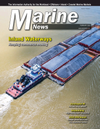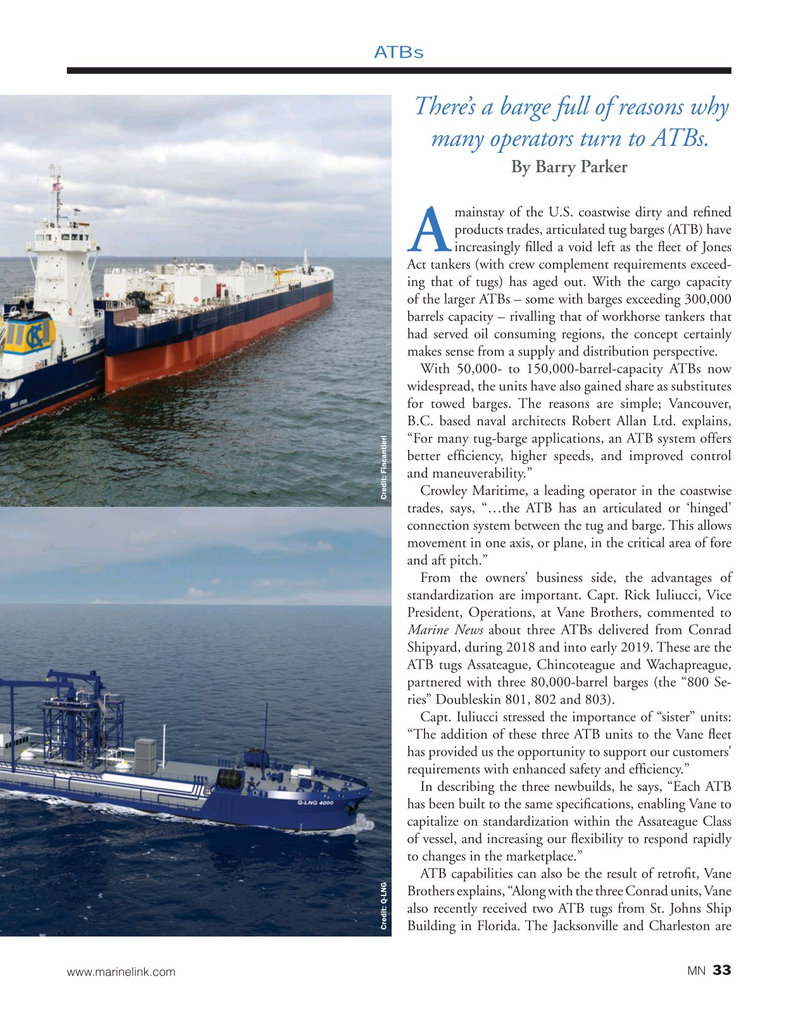
Page 33: of Marine News Magazine (February 2020)
Pushboats,Tugs & Assist Vessels
Read this page in Pdf, Flash or Html5 edition of February 2020 Marine News Magazine
ATBs
There’s a barge full of reasons why many operators turn to ATBs.
By Barry Parker mainstay of the U.S. coastwise dirty and re? ned products trades, articulated tug barges (ATB) have A increasingly ? lled a void left as the ? eet of Jones
Act tankers (with crew complement requirements exceed- ing that of tugs) has aged out. With the cargo capacity of the larger ATBs – some with barges exceeding 300,000 barrels capacity – rivalling that of workhorse tankers that had served oil consuming regions, the concept certainly makes sense from a supply and distribution perspective.
With 50,000- to 150,000-barrel-capacity ATBs now widespread, the units have also gained share as substitutes for towed barges. The reasons are simple; Vancouver,
B.C. based naval architects Robert Allan Ltd. explains, “For many tug-barge applications, an ATB system offers better ef? ciency, higher speeds, and improved control and maneuverability.”
Crowley Maritime, a leading operator in the coastwise trades, says, “…the ATB has an articulated or ‘hinged’ connection system between the tug and barge. This allows movement in one axis, or plane, in the critical area of fore and aft pitch.”
From the owners’ business side, the advantages of standardization are important. Capt. Rick Iuliucci, Vice
President, Operations, at Vane Brothers, commented to
Marine News about three ATBs delivered from Conrad
Shipyard, during 2018 and into early 2019. These are the
ATB tugs Assateague, Chincoteague and Wachapreague, partnered with three 80,000-barrel barges (the “800 Se- ries” Doubleskin 801, 802 and 803).
Capt. Iuliucci stressed the importance of “sister” units: “The addition of these three ATB units to the Vane ? eet has provided us the opportunity to support our customers’ requirements with enhanced safety and ef? ciency.”
In describing the three newbuilds, he says, “Each ATB has been built to the same speci? cations, enabling Vane to capitalize on standardization within the Assateague Class of vessel, and increasing our ? exibility to respond rapidly to changes in the marketplace.”
ATB capabilities can also be the result of retro? t, Vane
Brothers explains, “Along with the three Conrad units, Vane also recently received two ATB tugs from St. Johns Ship
Credit: Q-LNG Credit: Fincantieri
Building in Florida. The Jacksonville and Charleston are 33 www.marinelink.com MN

 32
32

 34
34
